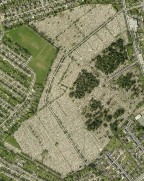Deaths & Burials - Deansgrange
A cemetery in which some of my family members are buried ....
Deans Grange Cemetery (Dublin)
The Burial Act of 1855 resulted in the closure of many of the older churchyards in Dublin and surrounds due to overcrowding. This drove the need to find new lands for cemeteries. The cemetery was laid out with just 2 sections, North for Catholic and South for Protestant religions as well as separate chapels for both. It also consisted of a Gate Lodge (Registrar's house) and yew trees lining the main walkways. The buildings were constructed by Matthew Gahan, whose name can be seen on the metal doors to the vaults under each chapel. Since Deansgrange opened in 1865, over 150,000 people have been buried in the cemetery.
DUBLIN
Family members buried in Deansgrange Cemetery are:
Margaret Crewe (d. 1892); Elizabeth Kennedy (d. 1897); Male Crewe (d.1906); Margaret Crewe (d. 1910); Mary Crewe (d. 1915); Hannah Crewe (d. 1929); Henry Crewe (d. 1943); Margaret Crewe (d. 1953); John Joseph Murtagh (d. 1962); Thomas Gerard Murtagh (d. 1981); Rebecca Murtagh (d. 1995); Carmel Murtagh (d. 2003)Family grave images ... Murtagh (from 1981), Murtagh (from 1962) and Crewe (from 1892)
Some people of note interred in this Cemetery - :
Anastasia Carey (1824–1865), the first interment in Dean's Grange Cemetery; Kathleen Clarke (1878-1972), widow of the Irish revolutionary Thomas J. Clarke; John A. Costello (1891–1976), former Taoiseach; John Boyd Dunlop (1840–1921), inventor; Barry Fitzgerald (1888–1961), actor; Seán Lemass (1899–1971), former Taoiseach; John Count McCormack (1884–1945), world-famous tenor; Dermot Morgan (1952–1998), comedian and actor; Brian O'Nolan (literary name Flann O'Brien) (1911–1966), novelist; Frank O'Connor (1903–1966), writer; John Howard Parnell (1846–1923), politician and older brother to lt Charles Stewart Parnell and Noel Purcell (1900–1985), actor.
Further information about Deansgrange Cemetery ...
It was 1865 when the cemetery took its first burial on 28 January 1865 of Anastasia Carey, buried near the Catholic chapel. There were four grave types to be chosen by the families:
1st Class located adjacent to the main pathways and considered the most prominent and most expensive.
2nd Class located adjacent to the smaller pathways and expensive.
3rd Class surrounded by other plots where payment was required within five years. Failure to pay resulted in the grave reverting to the Burial Board for reuse.
4th Class on loan and reverted to the Burial board for reuse after a number of years.
Since the opening of the cemetery two sections were added, South West and West, and the North section was extended. From the 1930s more land was bought and new sections were created and named after different saints bringing the total number of sections to 16. By the late 1980s the cemetery was running out of space and it was decided to stop selling new grave spaces. However, recent proposals around 2008 will see a small number of improvements and spaces made available.
1st Class located adjacent to the main pathways and considered the most prominent and most expensive.
2nd Class located adjacent to the smaller pathways and expensive.
3rd Class surrounded by other plots where payment was required within five years. Failure to pay resulted in the grave reverting to the Burial Board for reuse.
4th Class on loan and reverted to the Burial board for reuse after a number of years.
Since the opening of the cemetery two sections were added, South West and West, and the North section was extended. From the 1930s more land was bought and new sections were created and named after different saints bringing the total number of sections to 16. By the late 1980s the cemetery was running out of space and it was decided to stop selling new grave spaces. However, recent proposals around 2008 will see a small number of improvements and spaces made available.
Interred in the cemetery are people from notable events in local and Irish history:
The 15 local men of the Kingstown Lifeboat Disaster in 1895 who crewed a rescue boat involved in an attempt to rescue the Palme. During the 1916 rising, the cemetery saw the burial of about 50 people connected to the rising. The burials included innocent victims, republican volunteers and British soldiers. There is a plot with 6 people buried with the remaining being buried by their respective families. RMS Leinster was torpedoed by a German submarine 12 miles (19 km) from Dún Laoghaire in 1918. Eleven known victims are buried in the cemetery.
The 15 local men of the Kingstown Lifeboat Disaster in 1895 who crewed a rescue boat involved in an attempt to rescue the Palme. During the 1916 rising, the cemetery saw the burial of about 50 people connected to the rising. The burials included innocent victims, republican volunteers and British soldiers. There is a plot with 6 people buried with the remaining being buried by their respective families. RMS Leinster was torpedoed by a German submarine 12 miles (19 km) from Dún Laoghaire in 1918. Eleven known victims are buried in the cemetery.
British armed service victims of the 1916 rising and the Leinster sinking are among the 75 Commonwealth service personnel of World War I who are buried in this cemetery, as are 27 from World War II, whose graves are registered and maintained by the Commonwealth War Graves Commission.

